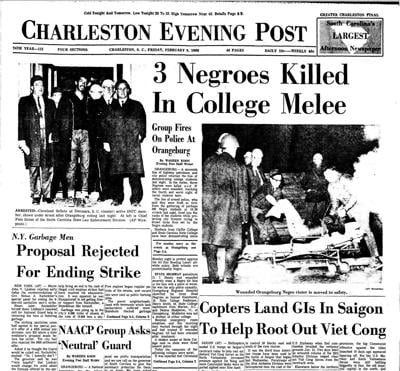

Good Morning POU! Today we honor the sacrifice and bravery of the students at South Carolina State University.
The Orangeburg massacre refers to the shooting of protesters by South Carolina Highway Patrol officers in Orangeburg, South Carolina, on the South Carolina State University campus on the evening of February 8, 1968. The approximately 200 protesters had previously demonstrated against racial segregation at a local bowling alley. Three of the protesters, African-American males, were killed and 28 other protesters were injured.

There were several incidents centering on the segregation of the local bowling alley, All-Star Bowling Lane, that led up to the Orangeburg Massacre on February 8, 1968. In the fall of 1967, some of the black leaders within the community tried to convince Harry K. Floyd, the owner of the bowling alley, to allow African Americans. Floyd was unwilling to desegregate; as a result protests began in early February 1968.
On February 5, 1968, a group of around 40 students from South Carolina State University entered the bowling alley and left peacefully after they were asked to leave by Floyd. The next night more students led by John Stroman returned and entered the bowling alley. This time there were police waiting for them and several students were arrested, including Stroman. After the arrests, more students began showing up, angry that protesters were being arrested. Next the crowd broke a window of the bowling alley and chaos ensued. Police began beating student protesters (both men and women) with billy clubs. That night, eight students were sent to the hospital.
Over the next couple of days the tension in Orangeburg escalated. Student protesters submitted a list of demands that consisted of integration and the elimination of discrimination within the community. The Governor of South Carolina at the time, Robert E. McNair, responded by calling in the National Guard after commenting that black power advocates were running amok in the community. Over the next two days, about 200 mostly student protesters gathered on the campus of South Carolina State University, a historically black college in Orangeburg, to demonstrate against the continued segregation at the bowling alley.
On the night of February 8, 1968, students started a bonfire at the front of the campus of South Carolina State University. As police and firefighters attempted to put out the fire, officer David Shealy was injured by a heavy wooden banister taken from a nearby unoccupied house and thrown in his direction. Shortly thereafter (around 10:30 p.m.) South Carolina Highway Patrol officers began firing into the crowd of around 200 protesters. Eight patrol officers fired carbines, shotguns, and revolvers at the protesters, firing for around 10 to 15 seconds. Twenty-seven people were injured in the shooting, most of whom were shot in the back as they were running away, and three African-American men were killed. The three men killed were Samuel Hammond Jr., Henry Smith (both SCSU students), and Delano Middleton, a student at the local Wilkinson High School.

Middleton was shot while simply sitting on the steps of the freshman dormitory awaiting the end of his mother’s work shift.
The police later said that they believed they were under attack by small arms fire. A newspaper reported: “About 200 Negros [sic] gathered and began sniping with what sounded like ‘at least one automatic, a shotgun and other small caliber weapons’ and throwing bricks and bottles at the patrolmen.” Similarly, a North Carolina newspaper reported that week that students threw firebombs at buildings and that the sound of apparent sniper fire was heard.
Protesters insisted that they did not fire at police officers, but threw objects and insulted the men. Evidence that police were being fired upon at the time of the incident was inconclusive, and no evidence was presented in court, as a result of investigations, that protesters were armed or had fired on officers.
At a press conference the following day, Governor Robert E. McNair said the event was “…one of the saddest days in the history of South Carolina”. McNair blamed the deaths on Black Power outside agitators and said the incident took place off campus, contrary to the evidence.
The federal government brought charges against the state patrolmen in the first federal trial of police officers for using excessive force at a campus protest. The state patrol officers’ defense was that they felt they were in danger and protesters had shot at the officers first. All nine defendants were acquitted although 36 witnesses stated that they did not hear gunfire coming from the protesters on the campus before the shooting and no students were found to be carrying guns.
In a state trial in 1970, the activist Cleveland Sellers was convicted of a charge of riot related to the events on February 6 at the bowling alley. He served seven months in state prison, getting time off for good behavior. He was the national program director of the Student Nonviolent Coordinating Committee (SNCC). In 1973, he wrote The River of No Return: The Autobiography of a Black Militant and the Life and Death of SNCC. Sellers was officially pardoned by the governor of South Carolina in 1993.
The Smith–Hammond–Middleton Memorial Center, South Carolina State’s on-campus arena, was renamed in honor of the three victims, opening the same year as the massacre.
